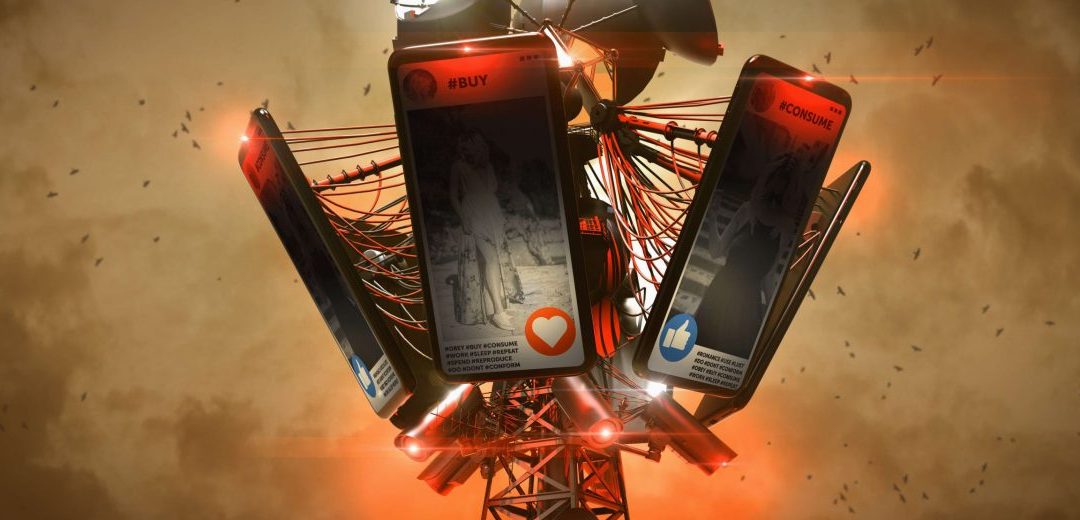Smartphones and Social Media: A Mass Surveillance Dystopia
The following is a transcript of the video found at the end.
In the book The Origins of Totalitarianism Hannah Arendt describes the rudimentary mass surveillance system used by the secret police force of the Russian Empire.
“Every suspect was noted on a large card in the center of which his name was surrounded by a red circle; his political friends were designated by smaller red circles and his nonpolitical acquaintances by green ones. . .cross-relationships between the suspect’s friends, political and nonpolitical, and the friends of his friends, were indicated by lines between the respective circles.”
Hannah Arendt, The Origins of Totalitarianism
This system was limited by the technology of the early-20th century, but “theoretically, a gigantic single sheet could show the relations and cross-relationships of the entire population” (Hannah Arendt, The Origins of Totalitarianism), and a network of this type Arendt called “the Utopian goal of the totalitarian secret police.” This goal, however, was not Utopian. This goal has been achieved, and in many ways, far exceeded. In this video, relying on the fascinating book by Jeremy Weissman, The Crowdsourced Panopticon, we are going to explore how modern communication technologies have given rise to the most dystopian mass surveillance states the world has ever known.
“Technology – a child of modern science – is out of humanity’s control, has ceased to serve us, has enslaved us and compelled us to participate in the preparation of our own destruction.”
Václav Havel, The Power of the Powerless
To be effective, a mass surveillance state requires the co-existence of two systems – a system of surveillance and a system of control. In his book Private Lies and Public Surveillance, James Rule defines a system of surveillance as consisting of “those activities having to do with collecting and maintaining information” (James Rule) so that those in charge know “when rules are being obeyed, when they are broken, and, most important, who is responsible for which.” (James Rule) Systems of control, on the other hand, consist of the actions, procedures and mechanisms used to enforce the rules, norms and laws of a society. Or in the words of Rule, a system of control consists of “the actual management of behaviour, through sanctioning or exclusion.” (James Rule)
In the mass surveillance states of the 20th century, be it the Soviet Union or East Germany, police forces, spies, civilian informants, judges and jailors were the key players in the systems of surveillance and control. But in modern surveillance states these systems are augmented by a peer-to-peer component. No longer are political suspects, dissidents, and others deemed to be enemies of the state, merely watched by police, followed by spies, or reported on by informants and no longer are judges and jailors the only ones to dole out punishment. Rather, we live in a world transforming into a panopticon-type of open-air prison where the many watch the many, and the many punish the few.
The Panopticon is an architectural creation of the 18th century philosopher Jeremy Bentham and as Weissman explains:
“The core of the Panopticon’s design consists of a roundhouse with prison cells encircling all sides, visibly open, light shining upon them, and stacked on top of each other to form circular walls. In the centre is a watchtower which is cleverly installed with a combination of venetian blinds and mirrors so that inmates in their cells, all at an equal distance from the tower, can never be sure if they are being watched by the guard.”
Jeremy Weissman, The Crowdsourced Panopticon
A smart phone in every pocket, smart devices all around us, and all constantly connected to the internet, has created a variation of the Panopticon that does away with the need for any special architectural design. We are surrounded by a public who embodies the potential gaze of guards. At any moment our actions can be recorded by another person and displayed to hundreds, thousands or even millions of people for quick, and sometimes ruthless, judgement.
“. . . the Panopticon broken free of [its] physical architecture” writes Weissman “. . . is a paranoiac delusion made reality as anyone may potentially be watching at any time—at least as soon as one steps foot out the front door. . .”
Jeremy Weissman, The Crowdsourced Panopticon
In this panopticon-type of peer-to-peer surveillance society we become in the words of Michel Foucault “the principle of [our] own subjection” (Michel Foucault, Discipline and Punish). Always knowing that our words and actions can be recorded and uploaded to social media leads to the emergence of a new form of justice based not only on the punishment of transgressors, but on preventing “even the possibility of wrongdoing, by immersing people in a field of total visibility where the opinion, observation and discourse of others would restrain them from harmful acts.” (Michel Foucault, Power/Knowledge) Or as Weissman explains:
“Through the state of constant uncertainty over whether one is being watched, [we] ultimately internalize the gaze of the guard, and in a sense become a guard over [ourself], constantly monitoring, judging, and correcting [our] behaviour, and eventually thoughts, and attitudes.”
Jeremy Weissman, The Crowdsourced Panopticon
But the peer-to-peer element of our mass surveillance society is not limited to the surveillance side of the equation, with police, judges and jailors left to take care of the system of control. Rather social media is a medium through which all can act as judge, jury, and in some cases, even executioner.
“. . .the method of managing behaviours [through the peer-to-peer element of the system of control]” writes Weissman “is done primarily through the sanctions of sometimes severe public shaming, humiliation, and psychological terror via unwanted global exposure of recorded content, “meme” manipulation of such content, uninhibited anonymous commenting. . . “doxing” and a deluge of threats. . .”
Jeremy Weissman, The Crowdsourced Panopticon
Of all these forms of punishment, the attempt to shame and humiliate is the most common and this is no innocuous form of punishment. For online shaming campaigns can reach traumatic proportions as their end goal is often the destruction of the targeted individual’s livelihood. If the target accepts the judgement of the social media mob and succumbs to the shame he or she will be led to believe that his or her very selfhood is irrevocably flawed, for as the author Peter Stearns explains
“[shame] emphasizes self-abasement. It is the self that is at fault, not [merely] the commission of the act.”
Peter Stearns, Shame: A Brief History
And as the psychologist Todd Kashdan writes
“…people who feel shame suffer. Shamed people dislike themselves and want to change, hide, or get rid of their self.”
Todd Kashdan, The Upside of Your Dark Side
Shame if too severe, or endured for too long, can cause mental illness, lead an individual to lash out at society, or in extreme cases even to take his or her own life.
“Shame is a problem emotion. . .shaming can go too far, causing levels of emotional pain out of proportion to offending behaviors. . . “
Peter Stearns, Shame: A Brief History
Social media has heightened the problematic nature of shame to levels never seen before. Prior to the internet, to shame someone, we typically had to be in their presence. This created a two-sided exchange, we would shame another, but we would also experience the effect our shaming had on this person which helped limit its severity. But with social media this exchange has become one-sided. Shielded by screens we don’t see the negative impact of our shaming. Instead, we see rewards in the form of likes, shares and comments commending us on the witness of our memes or comments. In addition, as but one in a crowd of thousands taking part in the act of online shaming, we can easily shirk responsibility for any harm done by telling ourselves that we played but a negligible part in the shamed individual’s downfall. This threat of being on the wrong side of a crowdsourced shaming campaign helps enforce a hyper-conformity as few dare run the risk of a ruined life at the hands of a social media mob.
“Individual and community resistance to the power of the public becomes increasingly snuffed out” writes Weissman “if one must constantly be aware that even a momentary spontaneous diversion from normality, from conformity with a mass approved script of speech and action, may be filmed, broadcast to the entire world, ridiculed for eternity, and lead to one being potentially cut off from society indefinitely. That’s a pressure that even the freest individuals can scarcely resist. . .”
Jeremy Weissman, The Crowdsourced Panopticon
But what makes living within a peer-to-peer mass surveillance society even more difficult is that the rules and norms we are expected to follow are constantly changing. What is permitted today, may not be tomorrow, and so even past actions can be the seeds of a future downfall. The situation is made even more sinister as the rules, norms, and values we are expected to follow are not an emergent and spontaneous by-product of the interactions of social media users, but are increasingly being shaped to align with the interests of certain corporations, governments and other powerful global institutions. By manipulating what we see and what we don’t see, and the frequency with which we see things, tech companies can effectively influence what we believe and what we value. The more time we spend glued to our screens, scrolling through these manipulated and censored social media feeds, the more we run the risk of becoming mere automatons serving the interests of a small group of elitists whose ultimate goal is to control and exploit us.
“To what extent, are modern technologies of surveillance, advertising, and control creating a new, modern slavery taken for granted because of its invisibility?” asks Oswald Sobrino “It is arguable that those controlled and deceived by modern technology are being transformed into the “slaves by nature” that Aristotle described and accepted as normal. . .[as our] modern subservience to technology shares many traits with ancient slavery by creating and resting upon an easily manipulated population.”
Oswald Sobrino, Technology and Human Existence
But can the tables be turned? Can these technologies be used to bring about our liberation instead of our enslavement? In the final video of the series, we will examine this question.
=============
Some of the art in this video was created by Andreas Varro – check out more of his excellent work here:
About us:
Academy of Ideas is the creation of two brothers from Canada. All of the content is produced by us. We are not supported by or affiliated with any organization or university. Our goal is to to spread the message of individual liberty and empowerment to the world.
Become a Supporting Member and gain access to our growing library of Membership videos (currently 40+ videos)! Learn more by following the link below:
© 2021 Academy of Ideas
– Come Like Us on Facebook – Check us out on Instagram –
– Sign Up for our Newsletter –
Subscribe to our New NOW Youtube Channel
&





 academyofideas.com
academyofideas.com







